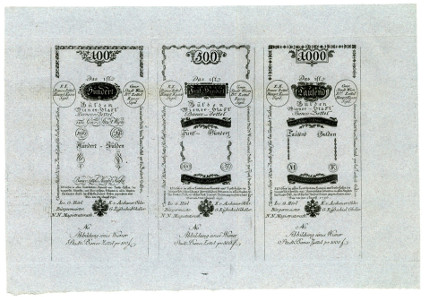By Joachim Stollhoff
Translated by Claire Franklin
There is a special coin among the lots offered at the Auction 42 of the Münzen & Medaillen GmbH: It’s a so called Wiener Stadtbancozettel Teilungsmünze, coined in 1807. The name sounds quite strange: What does it mean?
The Austrian copper coin which is illustrated above gives its nominal value in the reverse legend as: DREYSSIG KREUTZER ERBLAENDISCH. 1807. and around the square: WIENER ST(adt) BANCO ZETT(el) THEILUNGS MÜNZ Z(u) 30 K(reuzer). But what does that mean?
Vienna City Bank Notes. 100 Gulden. 1. 7. 1762.
Austria began with the issue of paper money in 1762. The war against Prussia had been going since 1756, the treasury was empty, and paper money was issued as a means to raise capital. The notes were issued by the City Bank of Vienna, the „Wiener Stadt Banco“, in 5, 10, 25, 50 and 100 Gulden (= florins). Later the denominations of 500 and 1000 Gulden and finally 1 and 2 Gulden were added. Paper money has some advantages compared to coined silver, for example, if you want to transport a large sum of it. It was guaranteed by the State, which was generally unproblematic, and people were happy to accept paper instead of silver coins.
Vienna City Bank Notes. 5 Gulden. 1. 6. 1806.
The problems started in 1792 when the wars against France commenced. This led to high expenditure, and the Austrian government tried to cover the costs by increasing the circulation of paper money. This resulted in a paper money inflation. The state produced coins for payments abroad, for the payment of soldiers etc., and it printed paper money for large sums. But now the purchasing power of coined money became disassociated from the value of paper money because there was so much paper and so little silver. Goods which cost 100 Gulden in coins were now priced at 150 Gulden in paper, and this rate got worse and worse. When the Austrian government decided to redeem the bank notes on Feb. 20th, 1811, it did so at a rate of 20 % of the nominal value.
Vienna City Bank Notes. 5, 10, 25, 50, 100, 500, 1000 Gulden 1. 8. 1796. Recto.
Now let’s say that someone buys three rolls in a baker’s shop for his breakfast. The baker charges him 3 Kreuzer, and the customer pays with a 1-Gulden-bill, the smallest bank note. One Gulden is 60 Kreuzer, so the change should be 57 Kreuzer. There were no Kreuzer bills, so the change had to be given in coins. But if the value of the paper Gulden is only 20 % of the value of coined money, then 57 Kreuzer in coins would be the equivalent of 4 ¾ Gulden in paper. The customer would receive more in return than he had given- and on top of that he would get his breakfast rolls for nothing. An alternative was that the baker and his customer agreed on a rate and worked out how much 57 Kreuzer of the paper currency were worth in real coins.
Vienna City Bank Notes. 5, 10, 25, 50, 100, 500, 1000 Gulden 1. 8. 1796. Verso.
The „Wiener Stadtbanco-Zettel Teilungsmünzen“, „Vienna City Bank Note Fractional Coins“, were produced for exactly such situations. They belonged to the system of the paper currency, and their value diminished together with the value of the paper money. Therefore the 30 Kreuzer piece (half a Gulden) was made of cheap copper. Its function was to be a fraction of a bank note, and it was not to be confused with the coins of the coin currency.
The coin and the bank notes illustrated here are taken from Münzen & Medaillen GmbH Auction Sale 42, which is taking place on June 3rd, 2015, in Stuttgart. 480 lots of early paper money produced before 1815 are being offered, with bank notes from France, Great Britain, Italy, Japan, Portugal, the United States, etc.
If you are interested in the objects featured in this article, you can go directly to the Auction Sale 42 of Münzen & Medaillen GmbH.
Of course, CoinsWeekly is also offering an auction preview of this sale.









